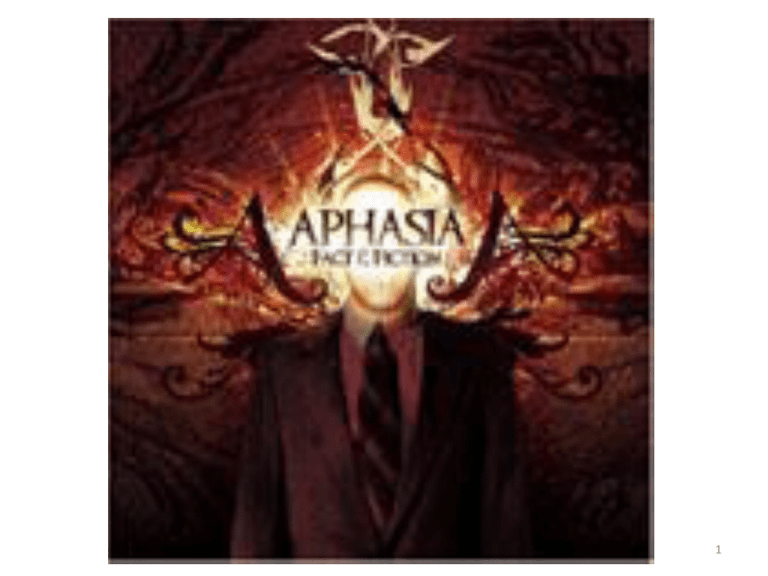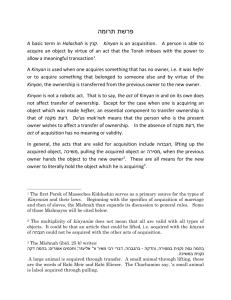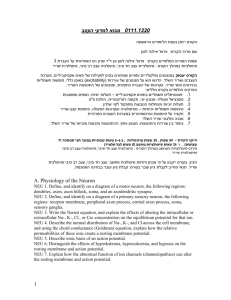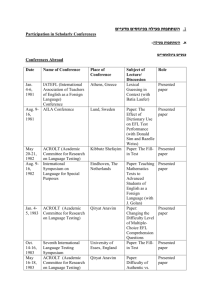Document
advertisement

1 פרק א' :קטגוריזציה מסורתית של סוגי אפזיה סוג האפזיה שטף הבנה חזרה דיסאינטגרציה פונמית (אגרמטיזם) Expressive פונמיות +סמנטיות Perceptive Conduction שיום פרפזיה פונמיות Global Trans. Sensory Trans. Motor Mixed Trans. 2 Lesions in BA 44 and 45 – Broca’s first patients 3 Fig. 3 Photographs of the brains of Leborgne and Lelong, Paul Broca’s first two aphasic patients. (A) Lateral view of the brain of the first patient, Leborgne. The external lesion is clearly visible in the inferior frontal lobe. The softening in the area superior and posterior to the lesion suggests further cortical and subcortical involvement. (B) Close-up of the visible lesion in Leborgne’s brain. (C) Lateral view of Broca’s second patient, Lelong. The frontal, temporal and parietal lobes have retracted due to severe atrophy, exposing the insula. (D) Close-up of the visible lesion in Lelong’s brain. Note that only the most posterior part of what is currently called Broca’s area is infarcted; the anterior portion is completely spared. Leborgne’s brain - MRI 4 Wernicke Aphasia 5 The brain of a patient who suffered from Wernicke’s aphasia due to a stroke in the left middle cerebral artery Conduction Aphasia • Language output is fluent • Content is paraphasic usually literal/ phonemic – attempt to produce repeated approximations of the word are called conduit d’approche • Repetition is poor, auditory comprehension is normal • Generally there is damage to supramarginal gyrus • Classical correlation was with the arcuate fasciculus, a bundle of nerve fibers that lies below the supramarginal gyrus in the temporal lobe and connects Broca's and Wernicke's areas 6 Conduction aphasia – Wernicke’s model 7 Conduction Aphasia: Geschwind’d model 8 Is it indeed a pure subcortical pathology? Alternatively, conduction aphasia might be induced by cortical dysfunction, which impairs the phonological output lexicon. We observed an epileptic patient who, during cortical stimulation of her posterior superior temporal gyrus, demonstrated frequent phonemic paraphasias, decreased repetition of words, and yet had intact semantic knowledge, a pattern consistent with conduction aphasia. These findings suggest that cortical dysfunction alone may induce conduction aphasia 9 Global Aphasia • Most severe of all aphasias- significant impairment in all aspects of language • Language output is severely limited and comprehension is very impaired • No repetition, naming or writing • Buccofacial and limb apraxia are common, right hemiplegia may also occur • Most typical lesion undercuts the entire perisylvian region • Much clinical variability is seen – ranging from frontal lesions to deep subcortical temporal lesions • Prognosis is poor – eventually patients may improve comprehension and qualify for severe Broca’s aphasia 10 Transcortical Sensory Aphasia 11 • Repetition is preserved but there is no comprehension and propositional speech • Semantic processing is affected and hence semantic paraphasia dominates • Occurs when Broca's area, Wernicke's area and the arcuate fasciculus are undamaged but are cut off from the rest of the brain by infarcted tissue • Lesions in middle and inferior temporal gyri • Such lesions would be found in Brodmann's areas 37, 22, and 39 Transcortical Motor Aphasia • Language output is non-fluent: initiation block, reduction in phrase length, simplification of grammatical form • Patients of TCMA are initially mute and may remain mute for many days • Echolalia (particularly incorporation) is observed • Repetition, articulation and oral reading are normal 12 • The classical patient has a large dorsolateral frontal lesion extending deep into the white matter • Connections between the Broca’s area and Brodmann’s Area 6, premotor area or basal ganglia are severed Mixed Transcortical Aphasia • Comprehension is impaired and naming is poor • Repetition is preserved • Echolalia and fragmentary sentence starters are common • MTA requires a combination of the lesions of TCMA and TCSA • Patients are mute initially. When they speak it is like patients with TCSA. • Most cases are due to large frontal lesions in the region of TCMA lesions. 13 חולשות הגישה האנטומית-קלינית איננה רגישה מספיק לשונות בין היכולות הלשוניות של חולים. היכולות הלשוניות של חולים אינן תואמות מספיק את החלוקה הקלינית. אין קשר ברור בין מהות הנזקים ובין הירידה התפקודית בתחום השפה, במיוחד במחלות ניווניות או גידולים. הגדרת התסמונת איננה מדויקת מספיק כדי לאפשר קביעת תוכנית טיפול 14 האלטרנטיבה :ניתוח בלשני ונוירו-בלשני של הליקוי השפתי יתרונות: תיאור מדויק של הליקוי תורם לקביעת תוכנית שיקום מתאימה יותר. מאפשר תיאור טוב יותר של התסמונת המאפיינת את החולה הפרטי. רגיש ללקויים ברמות לשוניות מורכבות יותר. יוצר קשר עם עולם ידע ובעיקר ,מתודולוגיות מחקר מתוחכמות יותר. תורם להבנת המנגנונים במוח המעורבים בתפקוד שפתי. חסרונות: מחייב ידע רחב יותר ,לעתי ידע שאיננו מצוי בידי צוות טיפולי. השונות הבין-אישית הרבה במיקום ואייפיון הרשתות העצביות המעורבות בתפקוד שפתי הופך את הגדרת התסמונות קשה עוד יותר. 15 פרק ב' :רמות עיבוד לשוני השימוש בשפה על בסיס הידע על העולם .הומור ,משמעויות כפולות, Pragmatics קונוטציות ומטפורות משמעויות המלים המשפטים והמסרים Semantics חוקי מבנה המשפט Syntax הטיות ,גזירות ,שורשים ,בניינים ומשקלים Morphology מבנה המלים Phonology צלילי השפה Phonetics "המנגינה" שבדיבור Prosody 16 תרשים זרימה של מערכת יצירת והבנת שפה CONCEPTUALIZER (Levelt, 1989) message generation discourse model pragmatic knowledge etc. monitoring preverbal message parsed speech FORMULATOR grammatical encoding LEXICON SPEECH COMPREHENSION SYSTEM lemmas Surface structure phonological encoding בלשנית-הגישה הנוירו 17 forms phonetic plan (internal speech) phonetic string AUDITION ARTICULATOR Overt speech Pragmatics הידע על העולם המאפשר תקשורת מילולית: 18 Prosody מאפשרת העברת מסר מעבר למשמעות הישירה של המלים קצב גובה צליל עוצמה דגשים הפסקות 19 עולם המושגים והמשמעויות • • • • • הבחנה בין עולם המושגים ומשמעויות של מלים קטגוריות סמנטיות סמנטיקה לשונית לעומת סמנטיקה תפיסתית. רשת סמנטית דינאמיקה ברשת: – קשרים סמנטיים – קשרים אסוציאטיביים 20 רשת סמנטית 21 תחביר תחביר ,דקדוק סדר המלים מילות קישור ויחס (“אל” “עם”“ ,ו”) האם התחביר מולד? Chomsky - חוקים אוניברסליים וספציפיים לשפה. 22 מורפולוגיה מורפמה -היחידה הפונולוגית הקטנה ביותר בעלת משמעות: מלים בעברית הן לפחות בי-מורפמיות מוספיות ,הטיות וגזירות ספר – ספרים ספר -ספריה בשפות רבות "מלות גזע" ( )stemומוספיות happy – happiness part – apartment – participation מיקומו של מידע פונולוגי בלקסיקון 23 פונולוגיה פונמה -היחידה הקטנה ביותר המשנה משמעות ברק = 5פונמות /b/ /a/ /r/ /a/ /k/ /b/ /a/ /r/ /a/ /d/ יחידה מופשטת – לא צלילית!! קטגוריזציה -נרכשת על ידי המערכת הלשונית בינקות התמרה פונטית-פונמית והתמרה גרפמית-פונמית מידע פונולוגי בלקסיקון: Syllabic structure Stress pattern of the word )Segmental contents of the syllables (onset and rime 24 פונטיקה צלילי השפה – יצירת קול על ידי ויסות וסינון זרמי אויר היוצאים מהראות. תכוניות פונטיות מבחינות ()distinctive features קוליות )Voice Onset Time (VOT Place of articulation אפיות עיצורים ותנועות ארטיקולציה – מערכת מוטורית המבצעת את עבודת הויסות והסינון תפיסה פונטית לעומת תפיסה אקוסטית – אפקט McGurkכדוגמה פענוח וקטגוריזציה פונטית – מושג הארטיקולציה המשותפת יכולת מולדת המבוססת על מנגנונים מוחיים ייעודיים. 25 בלשנית- ליקויי שפה – הגישה הנוירו:פרק ג ליקויים ברמה הפונטית Dysarthria (phonetic disintegration): A collective name for a group of related speech disorders that are due to disturbances in muscular control of the speech mechanism resulting from impairment of any of the basic motor processes involved in the execution of speech’ – A condition more frequent in non-fluent aphasia Speech apraxia: (Acquired and developmental): Problems with coordination of speech output. A difficulty putting sounds and syllables Nagao et al., 1999 together in the correct order to form words. Associated with lesions in the left anterior part of the insula. Aprosodia: (expressive and sensory): difficulties in expressing or comprehending emotional tone of speech (rhythm, pitch, stress, intonation, etc.) that usually occur following non-language-dominant hemisphere damage. 26 Cohen et al., 1994 בלשנית-ליקויי שפה – הגישה הנוירו .ליקויים פונמיים ופונולוגיים Phonemic substitutions, additions and deletions (itemspecific and feature specific) Conduite d’approche (more frequent in Broca than Wernicke and most frequent in conduction aphasia) Phonemic paraphasia Neologisms and jargon aphasia Word finding difficulties and phonological anomia Deficits of lexical (phonological) representations versus deficits of translation. 27 בלשנית-ליקויי שפה – הגישה הנוירו ליקויים בתחום הדקדוק Telegraphic speech Syntactic deficits Morphological deficits – inflectional morphology Sentence level disorders (relational; passive active; etc.) 28 בלשנית-ליקויי שפה – הגישה הנוירו ליקויים בתחום הסמנטי וליקויים על רקע ניוון מוחי Semantic paraphasia Primary Progressive Aphasia (Fronto-temporal lobar degeneration) Non-fluent variant (Progressive, non-fluent aphasia) Effortful speech, anomia, articulatory breakdown, phonemic paraphasia Semantic variant (Semantic dementia) Fluent aphasia, anomia, impaired comprehension and visual associative agnosia (semantic difficulties – Pyramids and Palm trees test). Logopenic variant (Logopenic progressive aphasia) Slow speech, impaired syntactic comprehension and naming difficulties Language disorders in fronto-temporal dementia 29 Primary Progressive Aphasia 30 Primary Progressive Aphasia 31 (Wilson et al, 2010) PPA – Disruptions of Fluency 32 PPA- Additional fluency problems 33 PPA- Lexical content problems 34 PPA – Syntactic structure problems 35 על הקשר בין מערכת מוטורית ושפה 36 36


